English

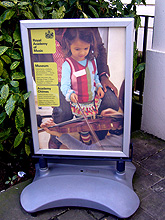
Poster of the Family Play Day
'Music in Community' was introduced to the Royal Academy of Music as an essential course on becoming a professional musician. It provides the community with not only students' visits to local schools, but also open workshops inside and outside the Academy in which anyone interested can participate. This article reports on a workshop that was held in collaboration with Academy Museum, and the following one will focus on a workshop collaborating with a movement expert.
Title: Family Play Day 'Composing for Fairies with Felix Mendelssohn'
Date: Saturday 10:30-12:00 (Ages 5-8)/ 14:00-15:30 (Ages 8-11)
Venue: Piano Gallery, the Royal Academy of Music Museum
Target: Families with children aged 5-11
Admission free, booking required
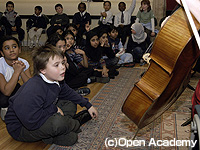
School workshop in the Academy
Families with children aged five to eight gathered in the morning, and those with children aged eight to eleven in the afternoon, in the Piano Gallery. Some of the children attended with both parents, while others came with family friends. Putting historic pianos aside, the families, the workshop leader, Julian West, and five RAM students sat on the floor in a circle, wearing nametags. Some of them had already visited the Academy before but, for most of them, this was their first visit to the Academy museum. When Julian asked them, 'What did you see on the way?', the children were already excited about being in a new place and cried out, 'Pianos!', 'Horns!', 'I saw some instruments being made'.
Many participants had experience of some musical instruments, such as the piano, cello, and drums, particularly in the older age group in the afternoon. As for the music workshops overall, some of them were invited by friends to attend for the first time, others had attended several family events, and others had RAM students as music teachers and had heard about the event from them. One enthusiastic parent told me that she was searching on the internet for an opportunity for her child to explore musical instruments before he decides which instrument to learn.
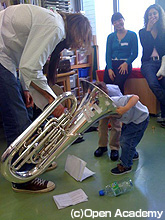
The theme for the day was 'A Midsummer Night's Dream' by Felix Mendelssohn. It was associated with the museum's temporary exhibition, 'Orchestral Magicians', which included the autograph manuscript by Mendelssohn. First, Julian played the beginning of the overture on the piano. He told the participants, 'This is the music composed by Felix Mendelssohn based on Shakespeare's "A Midsummer Night's Dream". It is just about to start, and getting into the mood of the story. Has anyone been to the theatre? Then you will understand the atmosphere when the lights go down and the curtain opens...'
'What I played now on the piano is actually played by many musicians, called an orchestra. Do you want to see what the score is like?' He showed a slide of Mendelssohn's manuscript from the museum collection and explained, 'This is his own handwriting. Do you know how to read it? On the left, there are the names of the instruments; oboe, clarinet, trumpet...And the music runs from left to right, all the same time, from up to down'. Seeing the score as an image, you can clearly see that some instruments start playing first, and then others join in.
When he asked, 'Do you want to play how it sounds?', the active children raised their hands. He handed them hand chimes which produce one note each, and let them hear the individual sound. Then they played four of them together to create the first harmony of the music. 'This is the very beginning of the story, like "once upon a time..." How do you want to start it?' he asked. One girl replied, 'I want to start very quietly', and they tried to play it gently. 'It feels like the beginning of the story', everyone agreed.
He showed a slide of a picture of a fairy and said, 'There are some fairies in the story. One of them, Puck, is mischievous and quick, and tricks people with his magic. Then there are scenes of sleeping in a forest, and even a big wedding!' H showed pictures of a forest and the wedding of Princess Diana. 'Could you guess which music goes with which scene? They will play the music', he said, and introduced the student musicians.
A flutist, a violinist, a French horn player, and a clarinetist played the first tune. Listening to the light, cheerful music, the children could not decide between 'fairies' and a 'wedding'. 'Let's listen to all of three, and you will know it'. The horn player started to play quiet, slow music. They raised their hands, 'It's sleeping, dreaming!' When the third tune was played, their faces brightened and they whispered to their mothers, 'I know! I heard it at the wedding!' Thus, they found out that the first tune was about fairies. They listened to it again.
Julian asked, 'How do you know it is the music of fairies?' Then the children answered, 'There are a lot of cheeky little steps', 'I can imagine fairies flying around'. Listening to it again, they could hear lots of quick, short notes. When he asked if it was loud or quiet, they replied that it was quiet. He said, 'Yes, Mendelssohn made his music using a combination of lots of quick, short notes and quiet, light sounds to express fairies'.
'Compared to that, what was the wedding music like? Why does it sound important and exciting? How was the speed?', he asked. One of the girls pointed to the picture of Princess Diana and said, 'It is slow, because she has to walk nice and slowly in that dress! It sounds like victory music'. 'It must be this sound. It is called a fanfare and, as you pointed out, it was played on a trumpet when they celebrate the victory of the war', he added and asked the next question. 'How did you know the second piece of music was about sleeping?' They replied, 'It was quiet and gentle', 'Slow', 'I felt sleepy'. He said, 'Yes, just one horn player was playing long notes slowly and gently'.
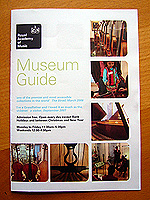
Museum Guide
Then, the participants and the musicians split into three groups and made their own music based on one of the three scenes. One group chose to make fairy music. The graduate student leader asked, 'What makes successful fairy music? How can we show that in music using these instruments here?' The children and parents offered ideas, such as 'Use lots of instruments and play short notes very quietly, like little steps', 'Higher notes rather than lower notes will fit'. Then, he let them explore the instruments, 'Let's grab an instrument you like and experiment with how you can make high, fast and quiet sounds!'
They showed how they found new sounds, by shaking maracas quickly and quietly, or tapping a drum gently with their fingers instead of beating it with sticks. 'Wow, drums and maracas are not only for loud and energetic sounds! You can produce various sounds with one instrument. You found it, well done!', the students praised them. They also experimented with the students' instruments. When a violinist played a harmony, a child said, 'It sounds sad. Could you play it faster?' Then the violinist played it with tremolo and pizzicato, 'How's this?', and made the children choose.
Thus, the ingredients of the music were decided. The next step is how to combine them. The student asked, 'Would you like to play them all together?' One girl said, 'No, I want to start with a few instruments, then add more, and finish quietly again'. He encouraged her to choose the first instruments. She chose the violin's tremolo and hand chimes, and made them play. 'It is a nice beginning!', everyone agreed. He asked another boy to choose which instruments to add. He pointed to a shaker, bongo, triangle, then a wood block, listening to how they sounded together. Another student was making a note. The violinist asked, 'Should I keep playing the same way?' Then the children asked her to change it to pizzicato. Listening to the rhythm of the pizzicato, a boy playing a bongo changed his rhythm to fit it. The students were surprised, 'You were listening to the violin very well. It sounds better together!' When all of the instruments joined in and played cheerfully, they had to decide how to end it. 'How's this?', asked a girl, banging a gong slowly three times. Everyone liked it: 'It sounds like the party has finished and gone back to the normal'.
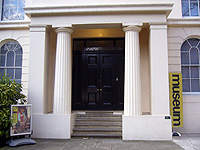
Entrance of the Academy Museum
After about 40 minutes of making music, each group performed its piece to the other groups. Watching the leader pointing at each musician in order with his bodily expression, they reconstructed the piece they had just created. Another group also chose to make fairy music, using different instruments and expressions. Each group performed its music without revealing its theme but, as they had learned some key things about each theme, everyone could tell what it was. Thus, 90 minute workshop on making and performing their own music came to an end with lots of applause. Julian said goodbye, saying, 'You can see the manuscript by Mendelssohn on the ground floor on your way out!'
A museum staff member, Fiona, told me, 'The Academy Museum used to hold annual workshops, but we thought that it would be better to have them more often, even if on a smaller scale. Having them regularly makes it easier for the family to expect the next opportunity, so we are planning to do it three times a year, once per term. We try to create workshops connected to the museum's collection, not just encourage people to visit the museum for irrelevant events. Otherwise, there is no meaning in doing them here.'
| 10:30-11:10 | Introduction, Musical workshop about 'Midsummer Night's Dream' |
| 11:10-11:45 | Music making in groups |
| 11:45-12:00 | Performance |
Report: Chigusa Futako








